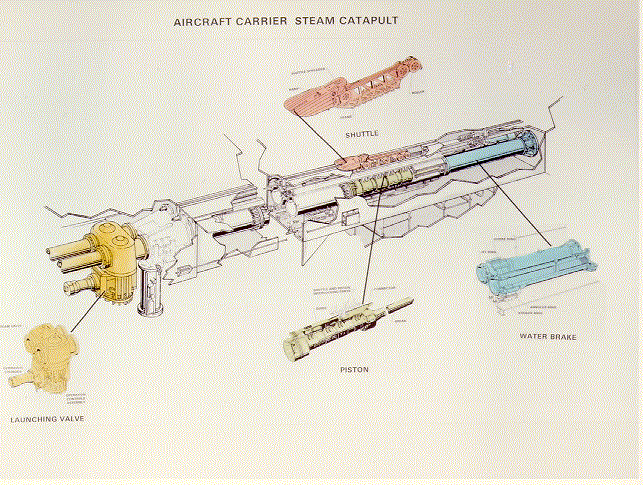

After the X-15 project I was transfered to the Internal Combustion Catapult project.
Ok, You say "What is that?". First let me explain the catapult.

Planes that require flying speed are launched from an aircraft carrier by a catapult using high
pressure steam. The problems with this are:
- Fresh water is needed to generate the steam
- As the catapult moves the pressure drops. The initial "kick" is very high and then the exceleration drops off.
The plane and pilot may be subjected to as much as 5G's at the start to get enough speed to get airborne.
This is why aircraft carriers always turn into the wind and increase speed to launch planes. To conserve
fresh water and reduce stress to pilots and planes.
Reaction Motors designed a system with a rocket engine that burned jet fuel and added salt water to generate
the steam. Both jet fuel and salt water are readily available at sea. The engine produced constant pressure
throughout the launch and a plane could be launched with as little as 2G's of constant excelleration.
This means that aircraft could be launched with less stress and even at flying speed downwind.

I was transfered to Lakehurst New Jersey. The left catapult is steam, the center was the Reaction Motors
catapult and the large building to the right is the steam house required to generate the steam for the steam
catapult.
Right about now you are probably wondering "if this thing was so great then why are we still using steam
catapults?". The answer is very simple.
In the latter stage of the project we turned the catapult operations over to Navy personel. The
arrangement was that if there were any problems the Navy personel could go home while we fixed it.
DUH!
Yup, we had problems. Leaks, cut wires, loose fittings, water in the hydrolics, you name it. Anything the
sailors could think of so they could get off work.
The boys in Washington looked at the numbers and in their infinate wisdom decided that the system was too
unreliable.
I worked on both catapult systems and believe me, the Reaction Motors system was far superior, less expensive
and more effective.






